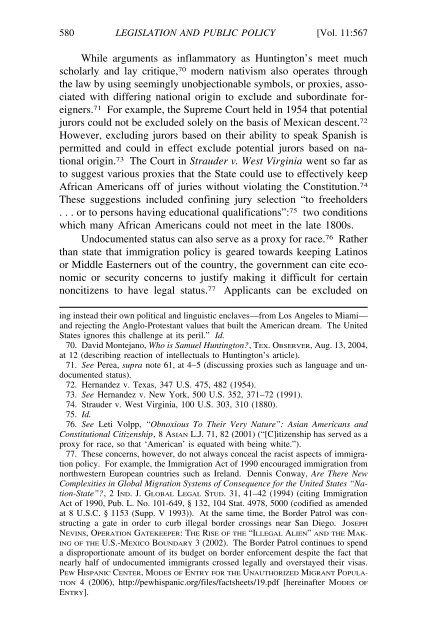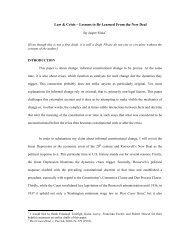updating brignoni-ponce - New York University School of Law
updating brignoni-ponce - New York University School of Law
updating brignoni-ponce - New York University School of Law
Create successful ePaper yourself
Turn your PDF publications into a flip-book with our unique Google optimized e-Paper software.
580 LEGISLATION AND PUBLIC POLICY [Vol. 11:567<br />
While arguments as inflammatory as Huntington’s meet much<br />
scholarly and lay critique, 70 modern nativism also operates through<br />
the law by using seemingly unobjectionable symbols, or proxies, associated<br />
with differing national origin to exclude and subordinate foreigners.<br />
71 For example, the Supreme Court held in 1954 that potential<br />
jurors could not be excluded solely on the basis <strong>of</strong> Mexican descent. 72<br />
However, excluding jurors based on their ability to speak Spanish is<br />
permitted and could in effect exclude potential jurors based on national<br />
origin. 73 The Court in Strauder v. West Virginia went so far as<br />
to suggest various proxies that the State could use to effectively keep<br />
African Americans <strong>of</strong>f <strong>of</strong> juries without violating the Constitution. 74<br />
These suggestions included confining jury selection “to freeholders<br />
. . . or to persons having educational qualifications”: 75 two conditions<br />
which many African Americans could not meet in the late 1800s.<br />
Undocumented status can also serve as a proxy for race. 76 Rather<br />
than state that immigration policy is geared towards keeping Latinos<br />
or Middle Easterners out <strong>of</strong> the country, the government can cite economic<br />
or security concerns to justify making it difficult for certain<br />
noncitizens to have legal status. 77 Applicants can be excluded on<br />
ing instead their own political and linguistic enclaves—from Los Angeles to Miami—<br />
and rejecting the Anglo-Protestant values that built the American dream. The United<br />
States ignores this challenge at its peril.” Id.<br />
70. David Montejano, Who is Samuel Huntington?, TEX. OBSERVER, Aug. 13, 2004,<br />
at 12 (describing reaction <strong>of</strong> intellectuals to Huntington’s article).<br />
71. See Perea, supra note 61, at 4–5 (discussing proxies such as language and un- R<br />
documented status).<br />
72. Hernandez v. Texas, 347 U.S. 475, 482 (1954).<br />
73. See Hernandez v. <strong>New</strong> <strong>York</strong>, 500 U.S. 352, 371–72 (1991).<br />
74. Strauder v. West Virginia, 100 U.S. 303, 310 (1880).<br />
75. Id.<br />
76. See Leti Volpp, “Obnoxious To Their Very Nature”: Asian Americans and<br />
Constitutional Citizenship, 8 ASIAN L.J. 71, 82 (2001) (“[C]itizenship has served as a<br />
proxy for race, so that ‘American’ is equated with being white.”).<br />
77. These concerns, however, do not always conceal the racist aspects <strong>of</strong> immigration<br />
policy. For example, the Immigration Act <strong>of</strong> 1990 encouraged immigration from<br />
northwestern European countries such as Ireland. Dennis Conway, Are There <strong>New</strong><br />
Complexities in Global Migration Systems <strong>of</strong> Consequence for the United States “Nation-State”?,<br />
2 IND. J. GLOBAL LEGAL STUD. 31, 41–42 (1994) (citing Immigration<br />
Act <strong>of</strong> 1990, Pub. L. No. 101-649, § 132, 104 Stat. 4978, 5000 (codified as amended<br />
at 8 U.S.C. § 1153 (Supp. V 1993)). At the same time, the Border Patrol was constructing<br />
a gate in order to curb illegal border crossings near San Diego. JOSEPH<br />
NEVINS, OPERATION GATEKEEPER: THE RISE OF THE “ILLEGAL ALIEN” AND THE MAK-<br />
ING OF THE U.S.-MEXICO BOUNDARY 3 (2002). The Border Patrol continues to spend<br />
a disproportionate amount <strong>of</strong> its budget on border enforcement despite the fact that<br />
nearly half <strong>of</strong> undocumented immigrants crossed legally and overstayed their visas.<br />
PEW HISPANIC CENTER, MODES OF ENTRY FOR THE UNAUTHORIZED MIGRANT POPULA-<br />
TION 4 (2006), http://pewhispanic.org/files/factsheets/19.pdf [hereinafter MODES OF<br />
ENTRY].
















